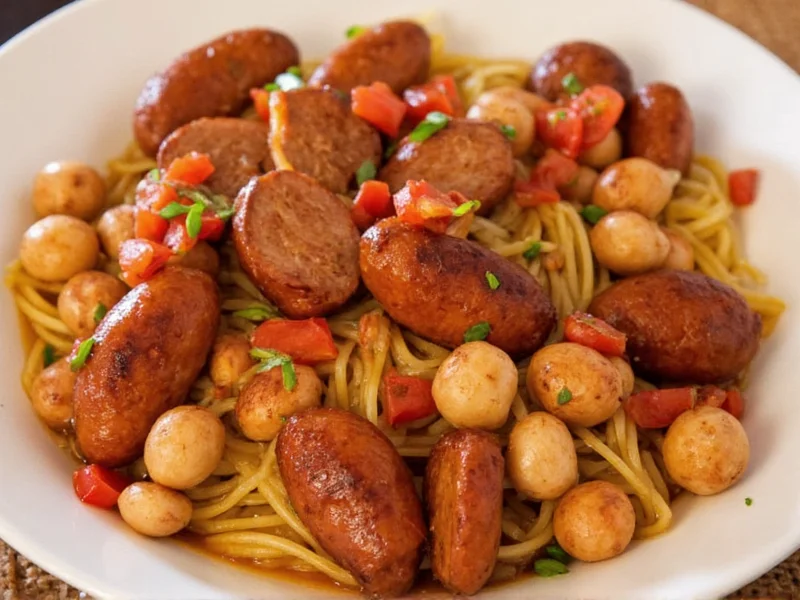Why Sausage Makes the Perfect Weeknight Dinner
Sausage transforms simple ingredients into restaurant-quality meals with minimal effort. As a culinary professional with two decades of experience, I've found Italian sausage particularly versatile due to its balanced seasoning of fennel, garlic, and black pepper. Unlike plain ground meat, quality sausage provides built-in flavor complexity that elevates even the most basic recipes.
Essential Ingredients for Authentic Flavor
The magic happens when quality ingredients work together. Don't substitute these core components:
| Ingredient | Quantity | Why It Matters |
|---|---|---|
| Italian sausage links | 1.5 lbs | Provides rich flavor base; choose sweet or hot based on preference |
| Bell peppers (mixed colors) | 3 medium | Creates visual appeal and sweet contrast to savory sausage |
| Yellow onion | 1 large | Develops foundational sweetness when caramelized properly |
| Garlic cloves | 4 | Adds aromatic depth; must be added late to prevent burning |
| Crushed tomatoes | 1 (28-oz) can | Creates rich sauce base without overpowering sausage flavor |
Step-by-Step Cooking Instructions
- Prepare ingredients: Slice peppers and onions into 1/2-inch strips. Mince garlic. Prick sausage links 3-4 times with fork.
- Brown sausage: Heat 1 tbsp olive oil in large skillet over medium-high heat. Cook sausage 5-6 minutes per side until golden brown. Remove and set aside.
- Caramelize vegetables: In same skillet, add peppers and onions. Cook 8-10 minutes until softened and edges brown. Stir occasionally.
- Add aromatics: Reduce heat to medium. Add garlic and dried oregano, cooking 1 minute until fragrant.
- Simmer together: Return sausage to skillet. Add crushed tomatoes and 1/2 tsp red pepper flakes (optional). Cover and simmer 15 minutes.
- Finish: Uncover and cook 5 additional minutes to thicken sauce. Sprinkle with fresh parsley before serving.
Professional Cooking Techniques Worth Knowing
Through years of recipe testing, these techniques consistently deliver superior results:
- Don't skip the sear: Proper browning creates fond (those browned bits at the bottom of the pan) which dissolves into the sauce, adding complex flavor notes.
- Temperature control: Cook vegetables over medium-high heat to achieve caramelization without steaming. High heat = better flavor development.
- Sauce consistency: Simmer uncovered for the final 5 minutes to concentrate flavors and achieve perfect coating consistency.
- Resting time: Let the dish rest 5 minutes off heat before serving. This allows flavors to meld and prevents burning your mouth.
Adaptations for Different Dietary Needs
This easy sausage and peppers recipe adapts beautifully to various requirements:
- Gluten-free: Naturally compliant - just verify sausage ingredients as some brands contain breadcrumbs.
- Lower-carb: Omit tomatoes and increase vegetable ratio. Add 1/2 cup chicken broth for moisture.
- Vegetarian alternative: Substitute plant-based sausage and use vegetable broth instead of meat drippings.
- Spice adjustment: For family-friendly version, use sweet Italian sausage and omit red pepper flakes.
Perfect Pairings and Leftover Ideas
Serve this traditional sausage and peppers dish with:
- Crusty Italian bread for soaking up delicious sauce
- Simple green salad with lemon vinaigrette
- Creamy polenta as a comforting alternative to bread
Transform leftovers into next-day meals:
- Breakfast hash: Chop and pan-fry with potatoes and eggs
- Pasta topping: Toss with cooked penne and fresh basil
- Pizza base: Use as topping for homemade sausage and peppers pizza
Common Mistakes That Ruin Sausage Recipes
Even experienced cooks make these errors when preparing sausage dishes:
- Overcrowding the pan: Causes steaming instead of browning. Cook sausage in batches if necessary.
- Adding garlic too early: Burns easily and turns bitter. Always add near the end of vegetable cooking.
- Skipping the fond: Those browned bits contain concentrated flavor. Deglaze with a splash of broth if they stick.
- Overcooking sausage: Pre-cooked sausage only needs heating through. Fresh sausage requires 160°F internal temperature.
Frequently Asked Questions
Can I use ground sausage instead of links in this recipe?
Yes, ground Italian sausage works perfectly. Brown it in the skillet first, then remove before cooking vegetables. You'll save the step of pricking and turning links, but may miss some textural variation from whole links.
How do I prevent peppers from becoming mushy?
Cut peppers into uniform 1/2-inch strips and add them to the pan before onions. The slightly longer cooking time they need ensures they soften properly without turning to mush. Never cover while cooking vegetables if you want them crisp-tender.
What's the best way to reheat sausage and peppers?
Reheat gently in a covered skillet over medium-low heat with a tablespoon of water or broth. Stir occasionally until heated through (about 8-10 minutes). Avoid microwaving as it makes sausage rubbery and vegetables soggy.
Can I freeze this sausage and vegetable skillet?
Absolutely. Cool completely, then store in airtight containers for up to 3 months. Thaw overnight in refrigerator before reheating. The flavors often improve after freezing as ingredients continue to meld. Tomato-based sauces freeze particularly well.











 浙公网安备
33010002000092号
浙公网安备
33010002000092号 浙B2-20120091-4
浙B2-20120091-4